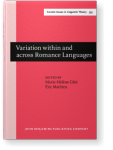References
Alvarez Martínez, María Angeles. 1987. Rasgos gramaticales del español de Canarias. La Laguna: Instituto de Estudios Canarios.
Álvarez Nazario, Manuel. 1992. El habla campesina del país. Río Piedras: Editorial de la Universidad de Puerto Rico.
Amado Acosta, Margarida & J. León Acosta. 2000. “Variedades del español y dialectos idiosincrásicos de los aprendices portugueses”. Polifonia 3.11–35.
Bhatt, Rajesh & Shoichi Takahashi. 2007. “Direct Comparison: Resurrecting the direct analysis of phrasal comparatives”. Proceedings of SALT 17 ed. by Tova Friedman & Masayuki Gibson, 19–36. Ithaca: CLC Publications.
Bosque, Ignacio & José María Brucart. 1991. “QP Raising in Spanish Superlatives”. Ms., Universidad Complutense, Madrid.
Chomsky, Noam. 1995. The Minimalist Program. Cambridge, Mass.: MIT Press.
Contreras, Heles. 1989. “Closed Domains”. Probus 1.163–180. 

Corver, Norvert. 1997. “
Much-Support as a Last Resort”. Linguistic Inquiry 28.275–343.
Demonte, Violeta. 2008. “Meaning-Form Correlations and Adjective Position in Spanish”. Adjectives and Adverbs ed. by Chris Kennedy & Louise McNally, 71–100. Oxford: Oxford University Press.
Doetjes, Jenny. 2007. “Adverbs and Quantification: Degrees versus frequency”. Lingua 117.685–720. 

Dowty, David. 1979. Word Meaning and Montague Grammar. Dordrecht: Reidel. 

Drubig, Gerhard. 1994. Island Constraints and the Syntactic Nature of Focus and Association with Focus. Arbeitspapiere des Sonderforschugsbereichs 340: Sprachtheorische Grundlagen für die Computerlinguistik, 51. Stuttgart & Tübingen.
García Cornejo, Rosalía. 2008. “El adverbio más y las palabras negativas del español”. Revista de Historia de la Lengua Española 3.29–77.
González-Rivera, Melvin. 2005. Variación sintáctica y lenguas en contacto: un estudio sincrónico del morfema –ndo español y sus rasgos semánticos y subcategóricos. M.A. thesis, Universidad de Puerto Rico, Río Piedras.
Heim, Irene. 1999. “Notes on Superlatives”. Ms., Cambridge, Mass.: MIT.
Kany, Charles. 1945. American-Spanish Syntax. Chicago: University of Chicago Press.
Kratzer, Angelika. 1996. “Severing the External Argument from its Verb Phrase”. Structure and the Lexicon ed. by Johan Rooryck & Laurie Zaring, 109–137. Dordrecht: Kluwer. 

Ladusaw, William. 1979. Polarity Sensitivity as Inherent Scope Relations. Ph.D. dissertation, University of Texas at Austin.
Lapesa, Rafael. 1980. Historia de la lengua española. Madrid: Gredos.
Lechner, Winfried. 2004. Ellipsis in Comparatives. Berlin & New York: Mouton de Gruyter. 

Lipski, John. 2001. “Strategies of Double Negation in Spanish and Portuguese”. Ms., Pennsylvania State University, University Park.
Lipski, John. 2006. El español de América. Madrid: Cátedra.
López, Luis. 2009. A Derivational Syntax for Information Structure. Oxford: Oxford University Press. 

Matushansky, Ora. 2008. “On the Attributive Nature of Superlatives”. Syntax 11.26–90. 

Mendoza Abreu, Josefa. 1985. Contribución al estudio del habla rural y marinera de Lepe (Huelva). Huelva: Excma. Diputación Provincial del Huelva.
Narbona, Antonio, Rafael Cano & Román Morillo. 1998. El español hablado en Andalucía. Barcelona: Ariel.
Pancheva, Roumyana. 2009. “More Students Attended FASL than CONSOLE”. Proceedings of Formal Approaches to Slavic Linguistics 18: The Second Cornell Meeting ed. by Wayles Browne, Adam I. Cooper, Alison Fisher, Esra Kesici, Nikola Predolac & Draga Zec, 382–399. Ann Arbor: Michigan Slavic Publications.
Pancheva, Roumyana & Barbara Tomaszewicz. 2011. “Experimental Evidence for the Syntax of Phrasal Comparatives in Polish”. University of Pennsylvania Working Papers in Linguistics 17:1.Article 21.
Pato, Enrique. 2011. “La construcción “más nunca” en el español moderno”. Paper presented at the
Asociación de Lingüística y Filología de América Latina (ALFAL)
, Alcalá de Henares, June 2011.
Pustejovsky, James. 1995. The Generative Lexicon. Cambridge, Mass.: MIT Press.
Real Academia Española de la Lengua (RAE). 2005. Diccionario panhispánico de dudas. Madrid: Santillana.
Sánchez López, Cristina. 1999. “La negación”. Gramática descriptiva de la lengua española ed. by Ignacio Bosque & Violeta Demonte, 2561–2634. Madrid: Espasa Calpe.
Vaquero de Ramírez, María. 1996. El español de América II: Morfosintaxis y léxico. Madrid: Arco Libros.
